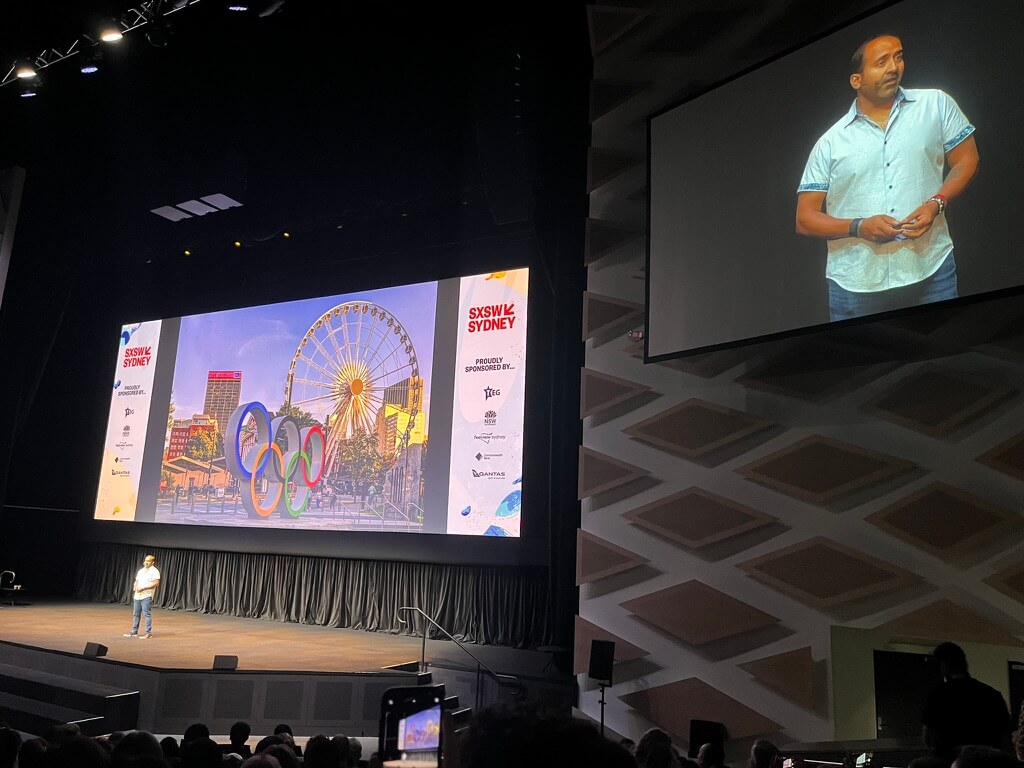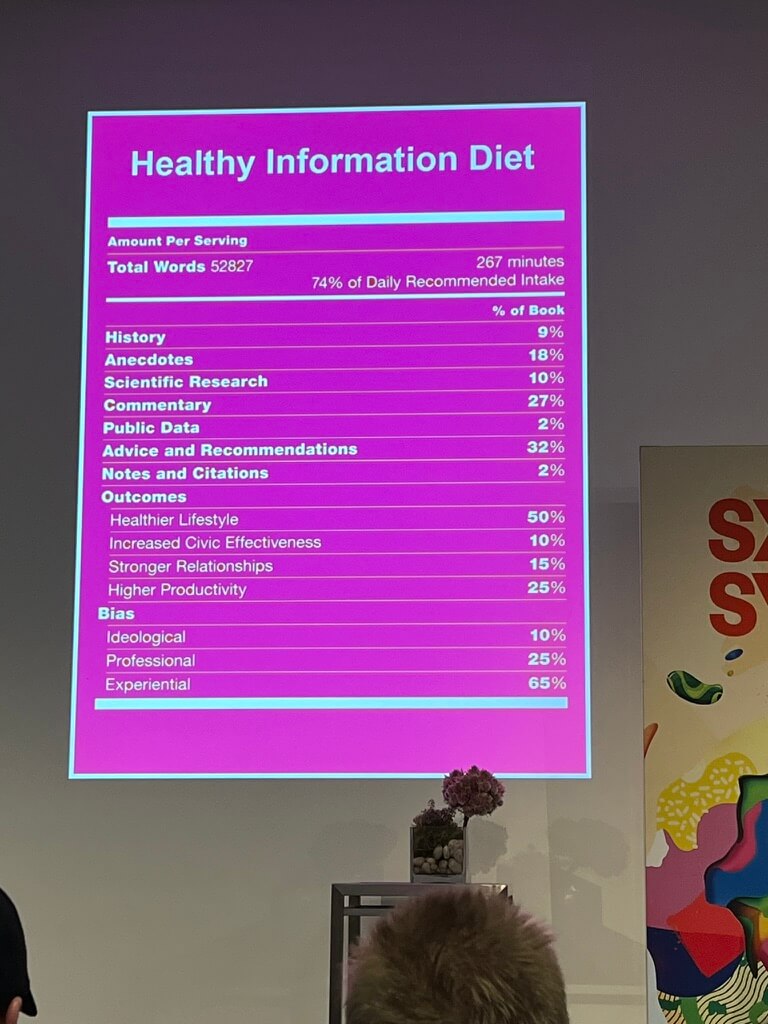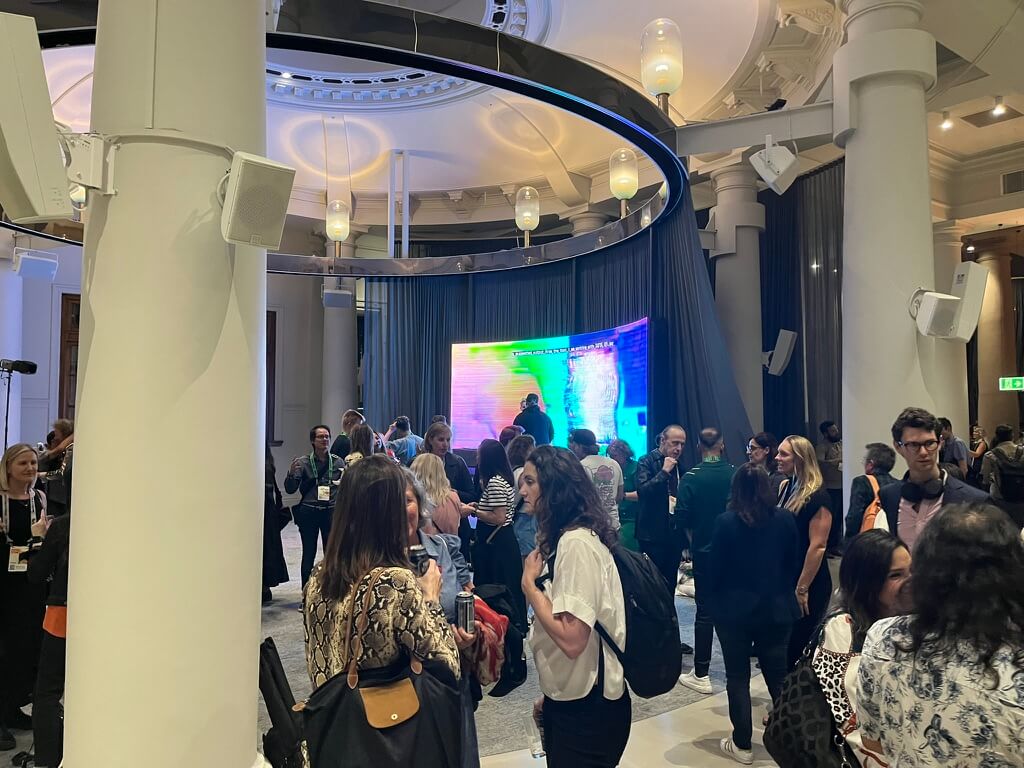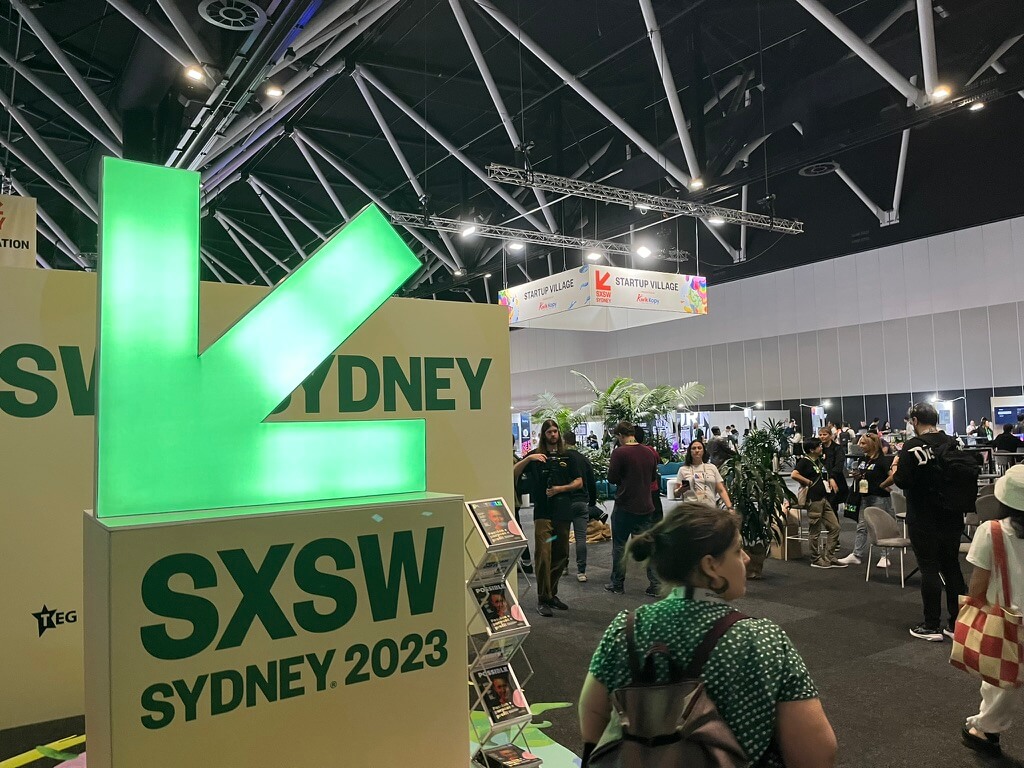By Mitchell Davis
Why SXSW Sydney?
Collating every part of my SXSW Sydney seems like a monumental undertaking, but it only feels right to start with the “My Deal” program, one of my favourite parts of the year at Mantel. As an alternative to the traditional performance review and bonus structure that’s more specifically tailored, we’re challenged to brainstorm ways to help improve ourselves as Mantelorians, whether investing in new computer hardware, taking extra parental leave, or getting support for personal projects.
When I had my fourth Mantel anniversary in April 2023, it didn’t take me long to decide what I wanted. I’d spent 10 days at SXSW Austin back in 2017, which, as a graduate engineer at the time, opened a whole world of possibilities before me. What was possible in the world of tech? How far could I take what I’d learnt in my career?
I joined the software industry in 2016 and after seven years, felt the time was ripe for a refresher. After a quick bit of costing up and some amateur slide design, I’d expensed my Platinum badge, and was on my way to SXSW 2023.
The Information Diet
I was keen to soak up as much of the festival as possible, and my Platinum badge yielded entry to the Tech/Innovation, Screen, Music and Games conferences, as well as the Innovation Expo and a wide variety of brand activations. From my experience in Austin, I’d recalled the importance of networking as much as possible, taking plenty of photos, and trying to plan out my days to give myself the best chance of attending as much as humanly possible. I remember planning to be a core part of the SXSW Austin experience, heading off from talks early and trying to ensure I could get to as much of my agenda as possible, knowing I’d inevitably miss a few things.

Rohit Bhargava’s talk was a massive highlight for me; he even signed a copy of his book for me!
SXSW started life (and arguably continues on) as a lifestyle-focused conference, which didn’t align neatly with my role as a QA. It wasn’t testing tools or quality methodologies that I expected to find there, and indeed, it’s not known as a very hands-on technical conference. The crux of SXSW was summed up best by featured speaker Rohit Bhargava from the Non-Obvious Company, who spoke to us at length about the power of divergent thinking. He cited Dick Fosbury as an influence; an American high-jumper who opted to flop backwards over the bar rather than straddling it as most of his contemporaries did. Not only did this approach yield success for him in the form of a gold medal at the 1968 Olympics, but it also had a ripple effect through the world of athletics, to the point where I can remember trying (and failing) to emulate the Fosbury flop in high school.
Of course, while the Sydney air was filled with the sounds of excitable networking and sharing of ideas, divergent thinking wasn’t just a switch that could be flipped. Much like the “garbage in, garbage out” that’s ruled computer science for decades, getting a good information diet into your brain would yield better outcomes. Tané Hunter and Shasta Henry from FutureCrunch described their concept of a “full-stack human” one that can ingest a good amount of positive data (like with a database), make the best use of that data and refine it for best use (as with an API), then present it out to the world, typically using bits of prior work pieced together with the glue of new ideas (as with a front-end). Their offering, which includes a news site that essentially surfaces good news, looked promising (and that I’ve already referred to a number of people already!). These thoughts persisted outside of the tech sphere; a special live edition of Wil Anderson’s “Question Everything” from ABC took over one of the halls in UTS and alternated between cautioning us about fake news and making us cackle.

I’d heard varying figures on the percentage of bad news pumped straight into our brains that affected our outlook on leave, but every one of those figures was shockingly high.
I’d heard varying figures on the percentage of bad news pumped straight into our brains that affected our outlook on leave, but every one of those figures was shockingly high.
With a healthy information diet, it was then time to use what we’d ingested. Nicole Celik’s session at JMC Academy imploring us to “think like Bowie” gave us some hints and tips for approaching a problem differently. Metaphors like “don’t drive a car with one foot on the accelerator” challenged us to carefully balance the boundless optimism of divergent thinking with the pragmatism of convergent thinking, but not attempt both simultaneously. She also advised us to think outside the box and look outside our own industry for inspiration, noting the ballpoint pen inspiring roll-on deodorant and gym sales strategies taking pointers from religions, cults and the military. Or, as it was put more briefly: stealing from within your own industry is theft, but stealing from outside your industry is innovation. It’s an idea that not only stuck out as an excellent takeaway quote but also coloured the rest of the festival for me.
AI Taking Over?
It segued neatly into probably the most prominent topic of the entire SXSW Sydney experience – artificial intelligence. The discourse around AI was thankfully conducted from a number of viewpoints, including discussing transparency and accountability. Our algorithms on sites like Facebook and X is already skewed according to the interests of advertisements, and there was a definite concern that we’d see the same thing start to emerge with the inputs into LLMs, with the view essentially being that large companies weren’t doing enough to protect consumers. Another critical point lay in the discussion of AI in storytelling, with a discussion inevitably heading towards the discussion of copyright and prior work. One of the panellists provided an interesting quote: that “We have a broken system, and creativity is being used for free”. With larger tools like ChatGPT being trained on publicly available data, it becomes inevitable that it will use and abuse the hard work of human artists and creatives. Solutions were being thrown around at various talks, but it’s obvious that this is a topic with considerable discourse still to be had.

The music and visuals for the Tech mixer were generated using AI by a local artist. Thoroughly interesting and more than a bit distracting!
The music and visuals for the Tech mixer were generated using AI by a local artist. Thoroughly interesting and more than a bit distracting!
From talking to creatives at the festival, there was a level of unease around AI, though some were adamant that we’d not see it replace genuine human connection and ingenuity. One observation was that AI isn’t good at interpreting nuance and is thoroughly unoriginal. A story of Salvador Dali’s creative process, wherein he would hold a spoon before falling asleep and drop it upon losing consciousness, in an effort to capture his semi-awake state, was used as an example of where AI would fall short. Rather, some of the more interesting points lay in using generative AI as a technology to restore and explore prior works, such as restoring lost media. This use of AI as a transformative tool rather than an existential threat to the arts gained a bit of traction, with one example, The New Born Times, adapting news articles for consumption by children.
Changing the Tech Landscape
Several other items in the world of tech demanded attention as well, with WPP (a major presence at the festival) discussing their thoughts on blockchain, NFTs and creator-driven economy, with an interactive exhibit taking over an event space underneath the Powerhouse Museum. XR continued its momentum, with an entire part of the expo set aside for XR experiences. Some of the highlights here included Pedal Rebel VR, where a controller is strapped to your leg while you pedal on an exercise bike to gamify the experience. Flintworks was another highlight, with it using VR to recreate traumatic locations for PTSD sufferers safely. Talking to XR enthusiasts at the various festivals gave me a great insight into a field I’d previously ignored; there’s much more to do with AR and VR that we haven’t seen.
New and interesting ways to apply technology dominated my SXSW experience. Startups involving more environmentally friendly ways of doing business and running computational workloads were fascinating, as well as new ways to handle learning & development and recruitment. A talk about female sports streaming (through services like Kayo) described ways to tap into the creator-driven mindset that dominates the modern internet. AWS’s large expo presence touched everything from sustainability to espressos to retail to basketball (with a neat real-time analytics demo examining your prowess at taking free throws).

The SXSW expo hall had something going on in every single corner, and the generosity of the stallholders with their swag left me well over my luggage weight limit for the way home!
The SXSW expo hall had something going on in every single corner, and the generosity of the stallholders with their swag left me well over my luggage weight limit for the way home!
Ultimately, one of my highlights was a neat counter-balance to the smorgasbord of tech wizardry and innovation: Charlie Brooker, British comedian and creator of Black Mirror. As someone who’s dabbled in the tech and creative worlds, I quite enjoyed his comparison between screenwriting and coding (as formal languages to express intent) and his natural concern for where tech is headed. As a self-confessed technology fan, he regards it with a level of scepticism, befitting of his stature as one of the 25 most important people in the AI space. Brooker noted the excitement over this new tech as “haunting”, and suggested that “tech companies should employ worried people”. As a QA who’s made a living out of being professionally worried, I couldn’t agree more.
Wrapping Up
It would be remiss of me not to mention some of the other less techy highlights of the festival. The Games expo showed how even small teams (ranging from uni students to industry long-timers) could leverage cutting-edge game tech to tell a story, to make people laugh, or just to help friends bond over a party game about jumping between planets. The Music Festival featured everything from rockers strutting about in Tumbalong Park to DJs spinning tunes in underground bars. The Screen Festival yielded some incredible films, with The Royal Hotel, an Aussie thriller through the female gaze, a personal highlight. Golden Era, a documentary about the making of the seminal console action game Goldeneye 007, was a fresh and exciting new look at an experience I’d treasured since childhood. As I mentioned earlier, trying to fit all of the eight days of SXSW Sydney into a few days is a monumental undertaking.
My SXSW experience ended under a sunny Sydney sky, watching pop science gurus Adam Spencer and Dr Karl Kruszelnicki discussing all sorts of big questions that the waiting crowd still had from the rest of the festival. There were children as young as 7 years old, bravely putting forward their questions and wanting to know more. I felt this was representative of that hunger for knowledge that permeated SXSW Sydney. With news that Sydney has signed a long-term deal with SXSW to continue bringing the festival Down Under, I’m keen to see how Sydney and SXSW grow together in the future.
A view of Sydney, with Tumbalong Park (where the core part of the SXSW experience) front and centre.
SXSW truly did leave an impression on the Harbour City, and I’m hoping to head back in 2024.